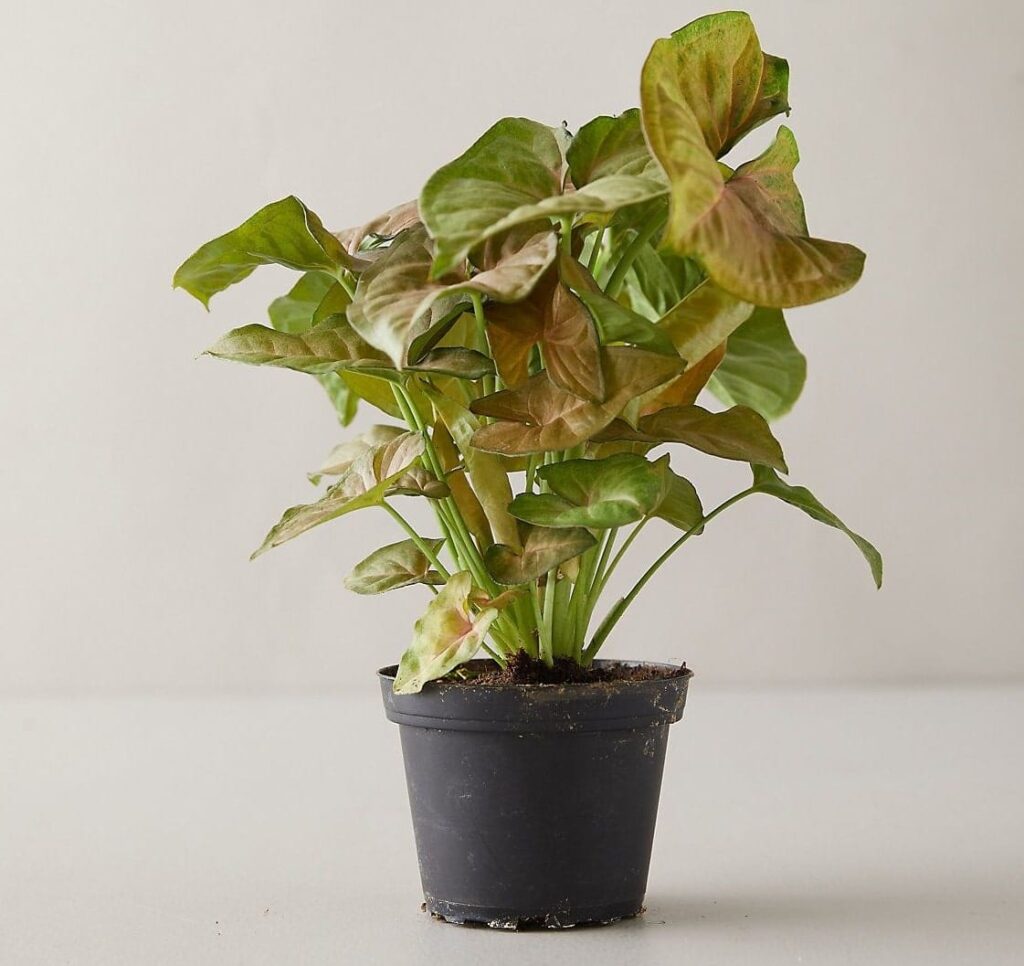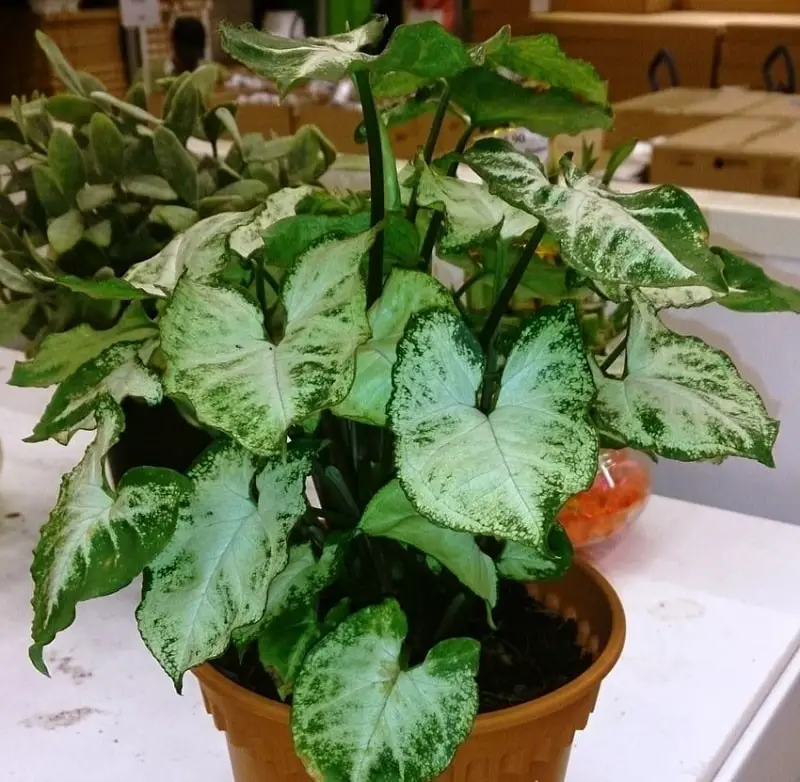The first time I bought my arrowhead plant, I struggled with several leaf-related problems for a couple of months. But most of these arrowhead leaves problems are super easy to fix.
Arrowhead leaves turning brown is a rare phenomenon. But Syngonium leaves turning yellow, and curling happens to be the most common problems.
So, why are my arrowhead leaves turning brown? The possible causes are over-fertilization, lack of humidity, under-watering, overwatering, direct sunlight exposure, leaf spot diseases, and pest infestations.
Examining the arrowhead leaves will help to identify the cause and adopt an appropriate measure to fix it. These actions will help to revive your arrowhead leaves from turning brown.
This article will walk you into some of the common causes of Syngonium leaves turning brown with their respective fixing tips. Take the time to read through from the start to the end.
You May Also Like: Why Are My Syngonium Leaves Curling?

Why Is My Syngonium Turning Brown? (Causes & Solutions)
The arrowhead plant leaves turning yellow and brown occur due to several reasons. Many houseplant enthusiasts have experienced them with the arrowhead.
Below are some of the reasons why arrowhead plants develop brown leaves. Let’s investigate and get to the bottom of each cause.
Lack of Humidity
Arrowhead plants love a warm and humid environment. The condition facilitates faster growth and production of beautiful foliages.
Low humidity around the plant will cause leaf tips and edges to turn brown. Besides that, the leaves will become droopy and shrivel in the long run.
Boosting the humidity level around the houseplant will help to save the leaves from turning brown and drooping. Arrowhead plants appreciate high humidity since they are tropical plants.
I recommend installing an electric humidifier to increase humidity over misting the leaves. Be sure to turn on the equipment during winter since the humidity level is dynamic.
Over-Fertilization
Arrowhead plants thrive in organic compost. These houseplants are not heavy feeders though fertilizer is super essential to facilitate better growth.
But too much fertilizer will make arrowhead leaves turn brown. The salt buildup around the roots becomes toxic to the plant.
The excess fertilizer inhibits the roots from carrying out their physiological activities. Water and nutrients deprivation causes the browning of the leaves.
Be sure to flush the potting mix with plenty of water. It will help get rid of excess minerals around the roots. I recommend using organic compost over artificial fertilizer.
Remember to apply fertilizer to the plant during spring and summer. Avoid the winter season because the arrowhead plant enters into dormancy stage.
Lack of Soil Moisture
Arrowhead plants appreciate moderate soil moisture to facilitate the faster growth and development of stunning leaves. Water helps the plant to undertake its physiological processes.
If you notice the leaf tips of your arrowhead plant turning brown and crunchy, the soil is likely to be too dry. If the condition persists, the houseplant leaves will start to droop and fall off.
Consistent under-watering happens to be the cause of leaves turning brown. Keep in mind that brown leaf tips will turn back to green after watering the plant.
Plant parents need to trim the brown leaf tips and edges to revive the plant. Besides that, they should consider a strict watering schedule to prevent the issue from occurring again.
Be sure to water the houseplant twice or thrice a month during the growing season. But limit the watering frequency during winter.
Direct Sunlight Exposure
Arrowhead plants are native to the rainforest of Latin America. These plants grow under the canopy, where they receive indirect sunlight.
Leaves turning brown could be due to direct sunlight exposure. The heat from the sun causes sunburn on the leaves. Reviving scorched leaves can be a daunting and challenging experience.
Syngonium plants are too sensitive to direct sunlight. The best option is to change their current location to an area that receives filtered sunlight.
Remember to expose the plant to bright indirect sunlight for three to six hours a day. It will help to enhance plant health and well-being.
Overwatering Problem
Overwatering is the leading cause of arrowhead leaves turning brown. It occurs due to improper soil drainage that facilitates sogginess and waterlogs.
If you notice your houseplant leaves turning brown and wilting, it is due to an overwatering issue. Consider appropriate measures at an early stage to save the plant.
Soggy soil promotes the development of root rot due to poor aeration. The damaged roots inhibit water and mineral absorptions.
You’ll also notice arrowhead plant leaves turning yellow and brown. The best solution is to re-pot the plant to a brand new container with fresh potting mix.
Remember to snip off the damaged roots with a sterilized pair of scissors. Stick to arrowhead plant care routine to an ultimate result.
Temperature Stress
Arrowhead plants are too sensitive to high temperatures. The houseplant usually displays the temperature stress on their leaves.
Arrowhead leaves turning brown is due to high heat around the plant. The heat scorches the leaves and results in ugly looks.
The best solution is to provide an optimum temperature that ranges from 65-85oF during the day. The temperature at night should be higher than 60oF to enhance better foliage development.
Leaf Spot Diseases
Arrowhead plants are more vulnerable to leaf spot diseases. The fungal disease is responsible for brown patches and spots on the leaves (Source: Pennsylvania State University).
Apply fungicide on the plant to get rid of the condition. Keep in mind that the brown arrowhead leaves will take time to regain their usual coloration.
Insect Infestations
Arrowhead plants are more susceptible to insect infestations. The most common pests attacking the houseplant are spider mites, scales, and mealybugs.
These sap-sucking bugs usually pierce the leaves and exhaust them. The frequent piercing ends up accelerating the browning and yellowing of the leaves.
The solution is to move the plant to a room with proper lighting conditions. Besides that, spray the houseplant with horticulture insecticidal to eliminate these pests.
You May Also Enjoy: Why Are My Arrowhead Leaves Turning Yellow?
Frequently Asked Questions (FAQs)
How Tall Do Arrowhead Plants Get?
It can grow up to 6 feet tall. But most houseplant enthusiast loves to keep their arrowhead small and bushy by pinching the stems and pruning.
Can You Grow Arrowhead Plant In Water?
Yes. But this technique is ideal when propagating the arrowhead. These houseplants grow faster and develop vines when grown in the soil.
Does Arrowhead Plant have Flowers?
Yes. Arrowhead plant flowers have three rounded petals, and these flowers later produce achene fruits. These fleshy rhizomes thrive in shallow ponds, lakes, and streams.

In Conclusion
Arrowhead leaves turning brown are due to over-fertilization, insufficient humidity, and improper watering routine. Identifying the cause of brown leaves will help to provide the roadmap to fixing it.
But arrowhead plant leaves turning yellow and brown are a less common phenomenon. You can use the fixing tips described in the article in case of their occurrences. Following a strict arrowhead plant care regime is the only way to prevent and avoid such scenarios.
You May Also Like:
